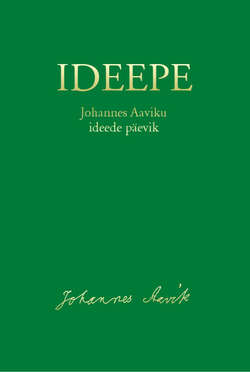Читать книгу Ideepe. Johannes Aaviku ideede päevik - Johannes Aavik - Страница 6
ОглавлениеPREFACE
Johannes Aavik, MA (1880–1973), who graduated from Helsinki University in 1910, was a teacher of Estonian, Latin and French, a docent at Tartu University (1926–1940), a member of the Education Council, Head Inspector of Second ary Schools and Gymnasiums at the Ministry of Education and Social Affairs of Estonia (1934–1940). Te author of Ideepe (1942–1943) Johannes Aavik was also a member of the Estonian Literature Society (1910), an honorary mem ber of the Academic Mother-Tongue Society (1937), founder and chairman of many cultural associations and member of board of editors of numerous maga zines.
On the anniversary of the Estonian Republic, on February 24, 1938, he was decorated with the Order of the White Star Tird Class in recognition of his accomplishments as a scientist and a member of society. On August 15, 1940, in what was then occupied Estonia, he was fired from all his posts. In the same summer, he lost his home in Tallinn, on Wiedemanni Street. Johannes Aavik was forced to stay in a rented family summer house, in Nõmme, from whence he escaped to Sweden in 1944.
Johannes Aavik transformed segments of his multilingual diary manuscript into a two-volume edition, called Ideepe, which he had exquisitely bound. Te title, Ideepe, derives from a pair of words: ideede päivik (diary of ideas). Te first part of the diary was written from January 31, 1942 to April 6, 1943 in Nõmme; the second part, from April 7 to December 1, 1943, in Nõmme and Kuressaare. Before the binding of the diary in Sweden, from September 18 to October 12, the author penned the book's foreword. Tis edition follows the manuscript closely, including the dates of writing and rewriting.
Tis linguistically and biographically interesting text, along with its peculi arities and Appendix, is remarkable from the perspective of literature and lan guage history and offers possibilities for linguistic and cultural analysis. It also casts light on the events and mood of the time. In the diary, Johannes Aavik reveals personal episodes undisclosed up to now, such as learning Arabic in Kuressaare in the 1920s, travelling to Paris in 1925, being forced to move to Nõmme in 1940 and others. An electronic dictionary of new root words is scheduled to be published in addition to the book.
Te diary's system of double dates – those of writing and rewriting – are pre served as follows: dates of writing are on the right (as in the manuscript), dates of rewriting, on the left (in the margin in the manuscript). For easier browsing, Johannes Aavik inserted topics for discussion at the top of the page and an index of these topics at the end of the book. As the pages have shifted in this edition, the topics are now in the body of the text. Te Index at the end of the book lists discussions of writers and literature, criticism, style and translation, art, philosophy, world view, language, war, daily life and creation, and interactions with writers and other cultural figures. Te Contents shows the format of both volumes: Te Diary of Ideas' linguistic side, a dictionary of new root words, an index of topics discussed and an index of names.
Publications of Johannes Aavik mentioned in the diary can be found in the book Johannes Aavik ja eesti keeleuuendus: Bibliograafia 1901–1996, (Tallinn 2000), edited by Helgi Vihma. In addition to being contained in numer ous encyclopedias in many countries, the name Johannes Aavik has also been entered in Lexicon Grammaticorum: Who's Who in the World History of Linguistics (Tübingen 1996).
Helgi Vihma
